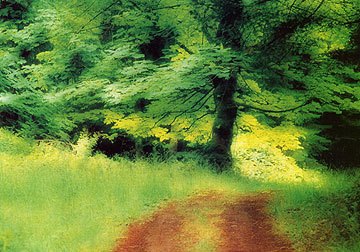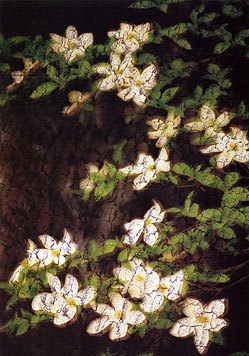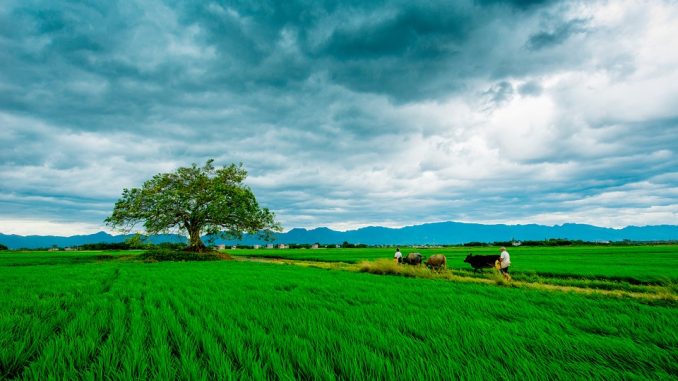What is photo creativity? Why do some people have it? Why don’t I? These are all perfectly normal, expected questions that we ask ourselves in search of the seemingly intangible.
There has long been a misconception that creativity could not be taught, that it was something inherited. The conclusion was that if you were not spontaneously producing “creative” work, you weren’t creative, and there was no point in your trying.
Truthfully, although there are individuals who are able to rise to higher levels than others, creative potential exists in everyone, and the height to which a person’s creativity soars is determined largely by desire, dedication, and persistence. Creativity does not just happen; we make it happen. What camera you choose makes no difference. It’s not about the equipment, it’s about you, the photographer.

I came upon the above scene on a late spring day when the grasses and leaves had not yet lost their fresh light green hues. I was limited as to the amount of tree that I could include in the image because of the distracting bright areas above. Bright overcast light created a wonderful translucence in the leaves and grasses, emphasizing the rejuvenation and new growth of spring.
The placement of the path invites the viewer to walk into the image. The softness and the saturated color were created by sandwiching two slides, one containing the color component, and one with the detail.
Creativity… Its definition will be a little different for each of us, but be aware that it is ongoing. It is the search, the trip, and not the destination.
Creative photography is the freedom to explore, uninhibited, the multitude of relationships between the camera, lens, film, light, subjects, and ourselves. It involves abandoning some of our preconceptions and going beyond the assumed boundaries of a photograph.
Think Of Creativity As A Ladder
You may feel that creativity is “over there” somewhere–out of your reach. Begin to think of creativity as a ladder, and move one rung at a time. This is not an ordinary ladder, for as we ascend, our grasp on creativity becomes more tangible.
The ladder’s end disappears into the distance. Do not despair; this is good! I call this the “creative climb effect.”
The more we explore, experiment, and experience, the more creative inspiration we gather. We are compelled to explore further, to experiment, and to experience more steps.
The lower rungs begin to pass by quickly once your climb begins, and it doesn’t hurt to look back (or down) and acknowledge this. Realize that your imagery has changed and will continue to evolve. Creativity for photographers is the recognition and realization of our own curiosity!
My first camera, a 35mm SLR, was a thirty-seventh birthday gift and came with only a small booklet of instructions. I was intimidated and tentative, but curious enough to load it with film to see what would happen.
How could this inanimate object see so well? There were all kinds of things in those pictures that I didn’t put there. I examined stones, bugs, sticks, weeds, and puddles, but was far too overwhelmed to consider the larger landscape.
This was object-oriented imagery at its worst. I continued for some months until another gift appeared, a book by Canada’s foremost creative photographer, Freeman Patterson. The images were stunning! I poured repeatedly over them, attempting to unlock the secrets of how such visual perfection had occurred–or, more correctly, been created.
From somewhere a distant voice whispered to me, “This is it!” Unknowingly, I was on the ladder to photo creativity.
If there was a photo club in town, I was unaware of it, but for some unexplained reason (could photography be art?), I attended the meetings and shows of the local art community. They talked about the world they saw in terms of tones, hues, edges, negative space, shadow, power, subtlety, saturation, pastels, motion, strokes, etchings and washes.
All of these techniques were unfamiliar to me, but I listened and watched, intent on working in the same fashion with photography.
Why not? While in this stage of absorbing the world in new ways and with my camera in hand, I hungrily devoured all available photographic images and other two-dimensional art. Inspired by my new insight, I made a decision.

In this image, one would think that my primary attraction to this situation was the flowers. Actually, the stark contrast or tonal difference between the flowers and the darkened tree trunk behind them caught my attention.
To emphasize this tonal difference even further, I made a slide sandwich of two exposures of the scene, and then sandwiched a third slide of oak tree bark, overexposed three stops, giving a painterly effect to the lighter areas.
THE CREATIVE CHOICE IN PHOTO CREATIVITY
” Photo Creativity” may be the word photographers use most, and yet, one they act upon reluctantly and tentatively at best. We are great “tech-tip grabbers” and gadget collectors, trying to emulate the pro sponsors and promoters of our next must-have consumer revelation.
The creative vision we occasionally conjure is too often mired in rules and guidelines enforced and propagated by other photographers.
Let’s be honest. As creative visionary artists, we photographers are too often the anchor, and not the ship of discovery we think we are (or would like to be). Where does this leave us? What are our options?
THE COMMITMENT
Can you repeat with conviction “From this day forth I will be as creative as I possibly can with my vision (how I perceive), and imagination (how I respond)”? If you take this dedication of purpose lightly and remember to use it only occasionally, then its effect on your creativity will be proportionate.
Consider this if it helps: You don’t have to erase the photographic knowledge and background you may have at this point, but instead, think in terms of supplementing and expanding upon the way you currently see and respond.
This is the first step toward creativity, but also the most difficult. Falling back on safe and established methods can happen all too easily, and in fact, often will.
Over the years, I have regularly had to stop and redirect my thoughts if I wanted to experience the challenge of new discoveries.
Your creative effort may be misunderstood, even unappreciated by some whose only measurement for successful photographic images is that they be sharp, un-manipulated reflections of what is called the real world.
This view has some merit, depending on the intended use of the image, but by the mere use of our cameras, we have already affected the viewers’ responses to the subject.
Choice of lens, shutter speed, ISO, and aperture, selection and abstraction from the whole scene, and use of specific angle and qualities of light are, in fact, the photographer’s desired interpretations.
Professionals–photographers who have chosen to seek remuneration for their work–have set themselves on a sort of tightrope, attempting to satisfy others and achieve inner satisfaction. Can creativity exist in such conditions?
When I find myself tightening up under the stress of expectations for images not yet found, I recognize that it is time to take a step back. It is time to reexamine where I came from and why, and once again, to exercise creativity for the pure joy and exhilaration of it! Ultimately, we are creative for ourselves.
SUMMARY – PHOTO CREATIVITY TIPS FROM APM:
1. Study the work of other photographers and artists.
2. Join a local photography club or artist group.
3. Examine your subject–discover the light, color, lines, shapes, and forms by looking carefully at all the visual possibilities.
4. Try it all–experiment. Try all the angles, various camera settings, a variety of subjects and different techniques.
5. Relax, enjoy the process and make lots and lots of images.
by Michael Orton
Adapted with permission from Photographing Creative Landscapes, by Michael Orton.





Leave a Reply